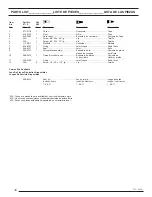
200-2228
3
SAFETY GUIDELINES
The following information relates to protecting YOUR SAFETY and PREVENTING EQUIPMENT PROBLEMS. To help you recognize this
information, we use the following symbols. Please read the manual and pay attention to these sections.
W ARNING
A POTENTIAL HAZARD THAT COULD CAUSE SERIOUS INJURY OR LOSS OF LIFE.
CAUTION
A POTENTIAL HAZARD THAT MAY C A U S E M O D E R ATE INJURY OR DAMAGE TO EQUIPMENT.
W ARNING
1.
TO REDUCE THE RISK OF FIRE OR EXPLOSION,
NEVER SPRAY FLAMMABLE LIQUIDS IN A
CONFINED AREA. It is normal for the engine to
produce sparks while operating. If sparks come into
contact with vapors from gasoline or other solvents,
they may ignite, causing fire or explosion. Always
operate the compressor in a well ventilated area. Do
not smoke while spraying. Do not spray where
sparks
or flame are present. Keep compressor as far from
spray area as possible.
2.
Do not weld on the air tank of this compres-
sor.
W elding on the air compressor tank can severely
impair tank strength and cause an extremely
hazardous condition. Welding on the tank in any
manner will void the warranty.
3.
Check the manufacturer s maximum pressure rating
for air tools and accessories. Compressor outlet
pressure must be regulated so as to never exceed
the maximum pressure rating of the tool. Relieve all
pressure through the hose before attaching or
removing accessories.
4.
High temperatures are generated by the
gasoline
engine, transfer tube, and the pump. To prevent
burns or other injuries, DO NOT touch these items
while the engine is running. Allow them to cool before
handling or servicing. Keep children away from the
compressor at all times.
5.
Be certain to read all labels when you are
spraying
paints or toxic materials, and follow the safety
instructions. Use a respirator mask if there is a
chance of inhaling anything you are spraying. Read
all instructions and be sure that your respirator mask
will protect you.
6.
Always wear safety goggles or glasses
when using
an air compressor. Never point any nozzle or sprayer
toward a person or any part of the body.
7.
Do not adjust the relief valve for any reason. Doing
so voids all warranties. The relief valve has been pre
set at the factory for the maximum pressure of this
unit. Personal injury and/or property damage may
result if the relief valve is tampered with.
8.
Risk of carbon monoxide poisoning. Engine
exhaust
contains carbon monoxide, an odorless and deadly
poison. DO NOT operate in an enclosed area. DO
N O T mount or operate in an enclosed vehicle, such
as a van.
9.
Risk of fire or explosion. Never operate the
gasoline
engine without the muffler properly installed; doing so
allows hot engine exhaust or sparks to vent directly
toward the gasoline tank.
10.
Risk of fire or explosion. Gasoline is flam-
mable and
gasoline vapors are
explosive. Sparking or heat from
engine, or from
other sources, can ignite gasoline.
DO NOT s
tart or operate with fuel cap removed.
DO NOT refuel while engine is running or still hot.
DO NOT overfill the tank there should be no fuel
in the filler neck.
DO NOT s
tart or operate if spilled gasoline or
smell of gasoline is present.
Operate and refuel only in a well ventilated area.
DO NOT store where gasoline vapors can reach:
an open flame
a pilot light, such as in a stove, furnace or water
heater
a spark.
CAUTION
1.
Drain the moisture from the tanks on a daily basis. A
clean, dry tank will help prevent corrosion.
2.
Pull the pressure relief valve ring daily to ensure that
the valve is functioning properly, and to clear the
valve of any possible obstructions.
3.
To provide proper ventilation for cooling, the
compressor must be kept a minimum of 12 inches
(31 cm) from the nearest wall, in a well ventilated
area.
4.
Fasten the compressor down securely if transporting
is necessary. Pressure must be released from the
tank before transporting.
5.
Protect the air hose from damage and puncture.
Inspect them weekly for weak or worn spots, and
replace if necessary.




































